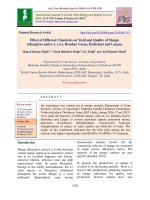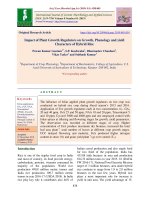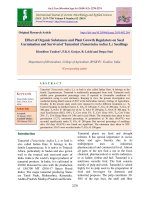Effect of plant growth regulators on yield and quality parameters of summer crop in acid lime (Citrus aurantifolia Swingle) cv. Balaji
Bạn đang xem bản rút gọn của tài liệu. Xem và tải ngay bản đầy đủ của tài liệu tại đây (189.18 KB, 7 trang )
Int.J.Curr.Microbiol.App.Sci (2017) 6(6): 2193-2199
International Journal of Current Microbiology and Applied Sciences
ISSN: 2319-7706 Volume 6 Number 6 (2017) pp. 2193-2199
Journal homepage:
Original Research Article
/>
Effect of Plant Growth Regulators on Yield and Quality Parameters of
Summer Crop in Acid Lime (Citrus aurantifolia Swingle) cv. Balaji
G. Ranganna*, K.T. Venkataramana, L. Mukundalakshmi,
K. Swarajyalakshmi and P. Sudhakar
Horticultural College and Research Institute, Anantharaju Peta, Dr. YSR Horticultural
University, Andhra Pradesh, India
*Corresponding author
ABSTRACT
Keywords
Plant growth
regulators,
Acid lime,
Yield,
Quality.
Article Info
Accepted:
26 May 2017
Available Online:
10 June 2017
A field study was conducted at AICRP on Citrus, Citrus Research Station, Tirupati,
Andhra Pradesh during the year 2015 under Dr. YSR Horticultural University, to find out
Effect of Plant growth Regulators on yield and quality parameters of summer crop in acid
lime (Citrus aurantifolia Swingle) cv. Balaji. Trees were sprayed with treatments viz
Spraying GA3 @ 50 ppm during June + CCC @1000 ppm during September + KNO 3 2%
during October, Spraying CCC @ 200 ppm (Chloromequat chloride) 1 st in August, 2nd in
September followed by light pruning in September and heavy irrigation in mid-October,
Application of Paclobutrazol @ 5 ml per meter canopy 4 times at 45 days interval starting
from July to December, Spraying NAA @ 200 ppm during December, Spraying 2, 4-D @
40 ppm during November + 20 ppm during February, Imposition of 30 days of soil
moisture stress during October followed by 50 ppm Ascorbic acid spray at release of
stress, Spraying ethephon @ 200 ppm during the month of October, With holding
irrigation (Bahar) for 30 days in September followed by application of recommended dose
of fertilizers and irrigation in the month of November and along with control (Not spray).
The data recorded from the results concluded that maximum number of fruits per tree was
(234.78) with the treatment application of Paclobutrazol @ 5 ml four times starting from
July to December (T 3), maximum fruit yield per tree was recorded with Spraying GA 3 @
50 ppm during June + CCC @ 1000 ppm during September + KNO 3 @ 2 % during
October (T1), Highest juice percent (53.59) recorded in the treatment spraying GA3 50 ppm
during June + CCC @ 1000 ppm during September + KNO 3 2% during October, Highest
TSS (8.42 0Brix) was recorded with spraying GA3 @ 50 ppm during June + CCC @ 1000
ppm during September + KNO3 @ 2 % during October (T 1), highest ascorbic acid content
(61.09 mg) was noticed in spraying GA3 @ 50 ppm during June + CCC @ 1000 ppm
during September + KNO3 2 % during October (T 1) and the differences for acidity among
the treatments was non-significant.
Introduction
Citrus is one of the largest and most important
groups of fruit crops in tropical and
subtropical regions. In India, among the fruit
crops citrus species covers an area of major
fruit crops is 10.4% with an area of 953.40
thousand ha, with production of 1, 17, 42, 000
MT, giving rise to Productivity of 8.7 MT per
ha estimated data NHB 2015-2016. As per the
data available (AP Horticulture online 201516), in Andhra Pradesh oranges and Batavia
2193
Int.J.Curr.Microbiol.App.Sci (2017) 6(6): 2193-2199
are being cultivated in 1, 21, 716 hectares
with the production of 1, 40, 78, 216 MT and
limes and lemons are grown an area of 111.09
thousand ha with production of 1717.34
thousand MT and productivity of 16.8 MT per
hectares during 2015-2016 (NHB, 2016.).
Acid lime (Citrus aurantifolia Swingle) is
considered as most important fruit crop
(Ghosh, 1990). It is considered to be native of
Malayan peninsula. It belongs to the family
Rutaceae, with chromosome number (2n=18).
It is mainly cultivated for its multi - fold
nutritional and medicinal values which made
acid lime more important among the fruits. Its
attractive appearance, penetrating aroma of
peel and excellent taste gives a remarkable
position to acid lime which is grown widely
throughout the world (Babu, 2001). Acid lime
fruits have great medicinal value. Being
acidic in nature, acid lime fruits have great
medicinal value. Acid lime is good appetizer,
anti helmentic and it checks biliousness and
stomach ache. Lime is used in making candy,
chocolate, ice cream, pastries and 100 grams
of fruit juice contains 80 percent of water,
carotene, 26 IU, Vitamin A, Vitamin B1 20
mg, Riboflavin 0.1 mg, Vitamin C 63 mg,
Iron (Fe) 1.83 mg, Copper (Cu) 0.16 mg,
Oxalo-acetic acid 0.30%, Malic acid and
alkaline salt 8.2% therefore it is very essential
for human health (Rangel, 2010).
The major constraints faced by the growers of
acid lime are the peak and lean production in
consecutive years. Flowering in acid lime is
recurrent under tropical and sub-tropical
conditions unless synchronized into welldefined period of extreme stress. Since the
demand for the fruit remains very high during
summer it is very essential to regulate
flowering that gives fruiting in the months of
April and May which fetches higher returns to
the grower compared to the income receive
during other seasons. There is difficulty in
fruit set because of incomplete pollination,
hence plant growth regulators may be
effectively used to increase fruit set. Hastabahar (September - October) management
through the use of plant growth regulators and
chemicals play an important role to get
maximum fruit yields during summer
(Mukunda et al., 2014). Hence there is a need
to test the plant growth [hasta-bahar
(September - October)] through the use of
plant growth regulators and chemicals for
their role inducing flowering for the hasta
bahar crop.
Materials and Methods
The present investigation were executed at
AICRP on Citrus, Citrus Research Station,
Tirupati, Andhra Pradesh during the year
2015 under Dr. YSR Horticultural University
with nine treatments viz, Spraying GA3 @ 50
ppm during June + CCC @1000 ppm during
September + KNO3 2% during October,
Spraying CCC @ 200 ppm (Chloromequat
chloride) 1st in August, 2nd in September
followed by light pruning in September and
heavy irrigation in mid-October, Application
of Paclobutrazol @ 5 ml per meter canopy 4
times at 45 days interval starting from July to
December, Spraying NAA @ 200 ppm during
December, Spraying 2, 4-D @ 40 ppm during
November + 20 ppm during February,
Imposition of 30 days of soil moisture stress
during October followed by 50 ppm Ascorbic
acid spray at release of stress, Spraying
ethephon @ 200 ppm during the month of
October, With holding irrigation (Bahar) for
30 days in September followed by application
of recommended dose of fertilizers and
irrigation in the month of November and
along with control (Not spray).
The experiment was laid out in a randomized
block design with three replications. The
effect of different treatments was studied on
yield parameters (no. of fruits per tree and
fruit yield per tree) and quality parameters
(Juice percentage, TSS, Acidity % and
2194
Int.J.Curr.Microbiol.App.Sci (2017) 6(6): 2193-2199
Ascorbic acid content) on six randomly
selected trees. The mean data were subjected
to statistical analysis following analysis of
variance technique (Panse and Sukhathme
1985).
Results and Discussion
Number of fruits per tree
Among the various treatments evaluated,
number of fruits per tree was found
significantly highest (234.78) with the
treatment application of Paclobutrazol @ 5 ml
four times starting from July to December
(T3) which was followed by spraying NAA @
200 ppm during December (222.56) and all
other treatments in the study were found on
par with each other. However, lowest number
of fruits (167.38) per tree was recorded with
the water spray (control). The results are in
conformity with findings of Tripathi and
Dhakal (2005) and Devi et al., (2011) in acid
lime. Paclobutrazol significantly increases
number of fruits per panicle and tree
particularly in pruned mango trees. Maximum
number of fruits could be due to increase the
hormonal activity by pruning and increase
number of perfect flowers, flower set, fruit set
and retention by Paclobutrazol application.
The increase the number of fruits per tree
with the application of Paclobutrazol, NAA
could be attributed to increase flower set
observed with the treatments initially
resulting in the more number of fruits per tree.
Fruit yield per tree
Significant differences were noticed in the
yield of acid lime tree due to the sprayings of
different plant growth regulators. Spraying
GA3 @ 50 ppm during June + CCC @ 1000
ppm during September + KNO3 @ 2 % during
October (T1) has recorded significantly
highest fruit yield per tree (13.61 kg)
compared to all other treatments fallowed by
application of Paclobutrazol @ 5 ml per meter
for four times starting from July to December
(12.08 kg). The lowest fruit yield was
recorded in control treatment (5.41 kg).
Similar results were obtained by Mukunda et
al., (2014) in acid lime. The increased fruit
yield attributed to the synthesis of chlorophyll
from source to sink which leads to increase
carbohydrate metabolism. This might be due
to more vegetative growth attained with GA3,
which increased the vegetative shoot
development at the initial sprays. Cycocel
sprays during September enhancing flower
bud initiation. KNO3 sprays at later stages
could have helped to set more fruits leading
highest yield per tree. The results are in
agreement with the findings of Thirugnanavel
et al., (2007) in acid lime, Jain et al., (2014)
high yield noticed with GA3 100 ppm in
Nagpur mandarin. Narayanlal et al., (2013)
who reported the highest yield per plant was
found in 50 ppm GA3 in guava. Debbarma
and Hazarika (2016) also reported the GA3 @
100 ppm + CCC @ 1000 ppm + KNO3 1 %
increases the yield in acid lime (Table 1).
Juice percent
Highest juice percent (53.59) recorded in the
treatment spraying GA3 50 ppm during June +
CCC @ 1000 ppm during September + KNO3
2% during October which was followed by
spraying NAA @ 200 ppm during December
(48.60) whereas, lowest juice (36.41)
percentage was recorded in control treatment.
The results are in conformity with the
findings of Mukunda et al., (2014) in acid
lime variety cv. Balaji. Similar results are also
recorded by Saleem et al., (2008) sweet
orange. Nawaz et al., (2008) in Kinnow
mandarin and Jagtap et al., (2013) in Kagzi
lime also reported increased juice percent
with foliar application of GA3 @ 50 ppm in
sweet orange. Gibberellic acid might have
increased the juice percentage of fruit by
stimulating the functioning of enzymes
2195
Int.J.Curr.Microbiol.App.Sci (2017) 6(6): 2193-2199
involved in physiological process. Cycocel
and potassium nitrate sprays could have
increased the juice content on account of their
role in increasing the mobilization of
carbohydrates from source to sink.
TSS
Highest TSS (8.42 0Brix) was recorded with
spraying GA3 @ 50 ppm during June + CCC
@ 1000 ppm during September + KNO3 @ 2
% during October (T1) followed by (T8)
withholding irrigation for 30 days in
September followed by application of
recommended dose of fertilizers and irrigation
in the month of November (8.22 0Brix).
Lowest (7.33 0Brix) TSS was recorded with
control treatment (7.32 0Brix). The results are
in accordance with the findings of Mukunda
et al., (2014) in acid lime cv. Balaji reported
the highest TSS of (8.42 0Brix). Similar
results are also reported by Debaje et al.,
(2011) and Debbarma and Hazarika (2016) in
acid lime. The higher TSS content, in the
treatments involving plant growth regulators
viz., GA3, Cycocel, Paclobutrazol, and NAA
could be due to stimulation of the functioning
of enzymes involved in physiological
processes and due to increase in the
mobilization of carbohydrates from source to
sink as opined by Mukunda et al., (2014).
Table.1 Effect of plant growth regulators on yield parameters of
summer crop in acid lime cv. Balaji
Treatments
No: of fruits
Fruit yield
per tree
per tree
214.83
13.61
211.16
10.28
234.78
12.08
222.55
10.11
220.91
9.61
208.91
9.45
212.54
9.30
218.82
9.43
167.38
5.41
SE(m) +
2.165
0.067
CD (5%)
6.547
0.202
T1 - Spray GA3 @ 50 ppm during June + CCC @1000 ppm
during September + KNO3 2 % during October
T2 - Sprayings 200 ppm CCC (Chloromequat chloride) 1st in
august, 2nd in September followed by light pruning in
September and heavy irrigation in mid-October
T3 -Drenching Paclobutrazol @ 5 ml per meter canopy 4
times starting from July to December
T4 - Spraying NAA @ 200 ppm during December
T5 - Spraying 2, 4-D @ 40 ppm during November +20 ppm
during February
T6 - 30 days of soil moisture stress during October with 50
ppm Ascorbic acid Spray at release of stress
T7 - Spraying ethephon @ 200 ppm during October
T8 – Withholding irrigation (Bahar) for 30 days in September
followed by application of recommended dose of fertilizers
and irrigation in the month of November
T9 - Control
2196
Int.J.Curr.Microbiol.App.Sci (2017) 6(6): 2193-2199
Table.2 Effect of plant growth regulators on quality parameters of
summer crop in acid lime cv. Balaji
Treatments
T1 - Spray GA3 @ 50 ppm during June +
CCC @1000 ppm during September +
KNO3 2 % during October
T2 - Sprayings 200 ppm CCC
(Chloromequat chloride) 1st in august, 2nd in
September followed by light pruning in
September and heavy irrigation in midOctober
T3 -Drenching Paclobutrazol @ 5 ml per
meter canopy 4 times starting from July to
December
T4 - Spraying NAA @ 200 ppm during
December
T5 - Spraying 2, 4-D @ 40 ppm during
November +20 ppm during February
T6 - 30 days of soil moisture stress during
October with 50 ppm Ascorbic acid Spray
at release of stress
T7 - Spraying ethephon @ 200 ppm during
October
T8 – Withholding irrigation (Bahar) for 30
days in September followed by application
of recommended dose of fertilizers and
irrigation in the month of November
Juice
TSS
percentage
Acidity
%
Ascorbic
acid content
53.59
(47.04)
8.42
6.79
(15.10)
61.09
45.47
(42.38)
8.15
6.69
(14.98)
45.18
47.86
(43.75)
8.09
6.56
(14.83)
48.83
48.59
(44.17)
45.19
(42.22)
SE(m) +
CD (5%)
7.66
6.40
(14.65)
6.50
(14.76)
38.41
54.92
46.73
(43.11)
7.93
6.52
(14.79)
44.10
46.03
(42.70)
7.59
6.95
(15.28)
45.08
44.90
(42.05)
8.22
7.29
(15.66)
45.21
36.41
(37.10)
0.338
1.022
T9 - Control
8.16
7.32
0.024
0.074
5.99
(14.16)
0.032
0.097
37.52
0.699
2.115
Acidity %
Ascorbic acid content
From the results it is observed that the
differences for acidity among the treatments
were non-significant. The lowest (5.99)
percent of acidity was observed with the
control treatment. However, the treatment i.e.
(T8) withholding irrigation for 30 days in
September followed by application of
recommended dose of fertilizers and irrigation
in the month of November gave significantly
highest (7.29) acidity percentage.
The ascorbic acid content was significantly
varied among the treatments. significantly
highest ascorbic acid content (61.09) was
noticed in spraying GA3 @ 50 ppm during
June + CCC @ 1000 ppm during September +
KNO3 2 % during October (T1) followed by
spraying of 2, 4-D @ 40 ppm during
November + 20 ppm during February (54.92)
whereas, lowest ascorbic acid content was
recorded in control treatment (37.52). Similar
2197
Int.J.Curr.Microbiol.App.Sci (2017) 6(6): 2193-2199
findings were also observed by Debbarma and
Hazarika (2015) in acid lime, Azher Nawaz et
al., (2011) with Kinnow mandarin, Debaje et
al., (2011) in acid lime and Jagtap et al.,
(2013) in Kagzi lime. The increase in the
ascorbic acid content could be attributed to
the role of plant growth regulators in breaking
down organic acids in to sugars at the time of
fruit ripening, further plant growth regulators
viz., GA3, 2, 4-D, Paclobutrazol and Cycocel
might have assisted the translocation of
sugars from vegetative parts to developing
fruits. It is also known that gibberellins are
known to play crucial role in the sugar
metabolism of plants (Table 2).
From the investigations it can be concluded
that maximum number of fruits per tree was
(234.78) with the treatment application of
Paclobutrazol @ 5 ml four times starting from
July to December (T3), maximum fruit yield
per tree was recorded with Spraying GA3 @
50 ppm during June + CCC @ 1000 ppm
during September + KNO3 @ 2 % during
October (T1), Highest juice percent (53.59)
recorded in the treatment spraying GA3 50
ppm during June + CCC @ 1000 ppm during
September + KNO3 2% during October,
Highest TSS (8.42 0Brix) was recorded with
spraying GA3 @ 50 ppm during June + CCC
@ 1000 ppm during September + KNO3 @ 2
% during October (T1), highest ascorbic acid
content (61.09) was noticed in spraying GA3
@ 50 ppm during June + CCC @ 1000 ppm
during September + KNO3 2 % during
October (T1) and the differences for acidity
among the treatments was non-significant.
References
Anonymous, 2015-16. National Horticulture
Board, Government of India.
Azher Nawaz, M, Afzal, M, Waqar, A,
Ashraf, M, Jaime, A, Silva, T, Akthar,
N, Shahzad, S.M, Hameed, U. and
Zahoor,
H.
2011.
Exogenous
application of 2, 4-D, GA3 and NAA at
flowering improves yield and quality of
Kinnow mandarin (Citrus reticulate
Blanco). The Asian and Australian
Journal of Plant Science and Bio
technology. 5(1): 17-21.
Babu, R. (2001). Lime and lemons. Handbook
of horticulture, ICAR. New Delhi. 212
pp.
Debaje, P, Shinde, P, Ekta, D. and Ingale,
H.V. 2011. Effect of plant growth
regulators and nutrients on quality of
Acid lime (Citrus aurantifolia Swingle),
Asian Journal of Horticulture. 6 (1):
253-255.
Debbarma, N. and Hazarika, B.N. 2016.
Effect of plant growth regulators and
chemicals on yield and quality of acid
lime (Citrus aurantifolia Swingle)
under foot hill condition of Arunachal
Pradesh. International Journal of
Agriculture,
Environment
and
Biotechnology. 9(2): 231-236.
Devi, H.L, Sarkar, S.K, Dhanabati, L. and
Majhi, D. 2011. Flushing - flowering
behavior and regulation in acid lime.
Journal of Crop and Weed. 7(2): 87-90.
Ghosh, S.N, Bera, B. and Ray, S. 2012.
Influence f plant growth regulators on
fruit production of sweet orange.
Journal of crop and Weed. 8(2): 83-85.
Jagtap, V.M, Patel, H.C, Nehet, D.S. and
Godage, S.S. 2013. Effect of foliar
application of plant growth regulators
and micronutrients on yield and quality
of acid lime cv. Kagzi (Citrus
aurantifolia Swingle). The Asian
Journal of horticulture. 8(1): 57-59.
Jain, M.C, Choudhary, H.D, Sharma, M.K.
and Bhim Singh. 2014. Yield and
quality attributes of Nagpur mandarin as
affected by use of different plant growth
regulators. Environment and Ecology
32: 1141-45.
Mukunda, L.L, VenkataRamana, K.T,
SivaramaKrishna, V.N.P, Yuvaraj,
2198
Int.J.Curr.Microbiol.App.Sci (2017) 6(6): 2193-2199
K.M, Nagalakshmi, T, Sarada, G,
Gourisankar, T, Gopi, V. and Gopal, K.
2014. Effect of growth regulators and
chemicals on fruit yield and quality of
hasta bahar flowering in acid lime
(citrus aurantifolia swingle) cv. Balaji.
Journal of Agriculture and Allied
Sciences. 3(3): 11-13.
Nawaz, M.A, Ahmad, W, Ahmad S. and
Khan, M.M. 2008. Role of growth
regulators on pre-harvest fruit drop,
yield and quality in Kinnow mandarin.
Pakistan Journal of Botany. 40(5):
1971-1981.
Panse, M. and Sukhathme, K. 1985. Statistical
methods for agriculture workers. Indian
Council of Agriculture Research
Publications. 48-67.
Rangel, C.N, Carvalho, L.M.J, Fonseca,
R.B.F, Soares, A.G. and Jesus, E.O.
2010. Nutritional values of organic acid
lime. Food Science and Technology.
31(4): 918 – 922.
Saleem, B.A, Malik, A.U, Pervez, M.A,
Khan, A.S. and Khan, A.M. 2008.
Spring application of growth regulators
affects fruit quality of Blood Red sweet
orange. Pakistan Journal of Botany. 40:
1013-1023.
Thirugnanavel, A, Amutha, R, BabyRani, W.
and Indira, K. 2007. Studies on
regulation of flowering in Acid lime
(Citrus aurantifolia swingle). Research
journal of agriculture and biological
sciences. 3: 239-241.
Tripathi, K.M. and Dhakal, D.D. 2005. Effect
of paclobutrazol on off-season flower
induction in acid lime (Citrus
aurantifolia Swingle) land races under
Chitwan condition. Journal of the
Institute of Agriculture and Animal
Science. 26: 87-92.
How to cite this article:
Ranganna, G., K.T. Venkataramana, L. Mukundalakshmi, K. Swarajyalakshmi and Sudhakar,
P. 2017. Effect of Plant Growth Regulators on Yield and Quality Parameters of Summer Crop
in Acid Lime (Citrus aurantifolia Swingle) cv. Balaji. Int.J.Curr.Microbiol.App.Sci. 6(6):
2193-2199. doi: />
2199


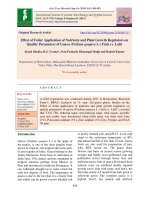
![Effect of different plant growth regulators on shooting of stem cuttings in dragon fruit [Hylocereus undatus (Haworth) Britton & Rose]](https://media.store123doc.com/images/document/2020_01/09/medium_isb1578564896.jpg)
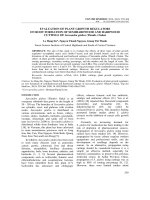
![Combining ability studies in forage sorghum [Sorghum bicolour (L.) Moench] for yield and quality parameters](https://media.store123doc.com/images/document/2020_01/09/medium_uoj1578577680.jpg)
